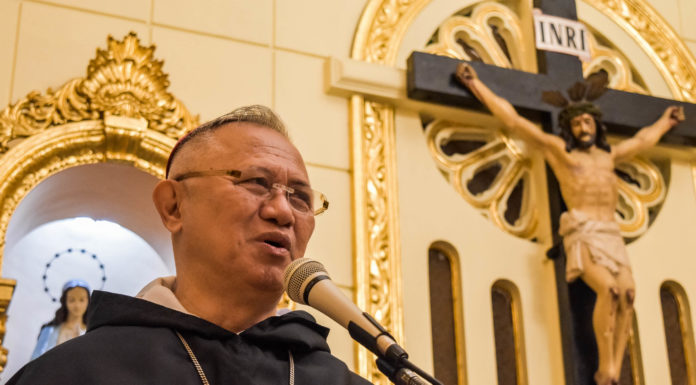 SIX THOMASIAN martyrs were declared “Blessed” in the biggest beatification in history presided by Cardinal Jose Saraiva Martins, prefect of the Vatican’s Congregation for the Causes of Saints, at St. Peter’s Square in Rome last October 28.
SIX THOMASIAN martyrs were declared “Blessed” in the biggest beatification in history presided by Cardinal Jose Saraiva Martins, prefect of the Vatican’s Congregation for the Causes of Saints, at St. Peter’s Square in Rome last October 28.
The 498 beatified martyrs, who died in the hands of an anticlerical movement in Spain in the early 1930s, were composed of two bishops, 24 diocesan priests, 462 religious, one deacon, one sub-deacon (a position which does not exist today), one seminarian, and seven lay people.
According to Fr. Pedro Tejero, O.P., spiritual director of the UST Central Seminary, the beatification rites should serve as sort of a stimulus for the renewal of Christian life and the promotion of the spirit of reconciliation.
“One thing great about this beatification is that there was no report of denial or apostasy against the martyrdom of the candidates,” Tejero told the Varsitarian. “These martyrs died while forgiving their murderers.”
Of the 462 religious martyrs, 74 are Dominicans, with 21 of them coming from the Province of the Holy Rosary, the Dominican Order’s largest province with missions, churches, priories and schools in Asia, Europe, and South America.
Of the 21 martyrs of the Province of the Holy Rosary, eight had either taught or studied in the Philippines before returning to Spain ahead of brewing social unrest. Six had UST connections.
A UST Dominican, Fr. Buenaventura Garcia Paredes, O.P., later rose to become the master general of the Dominican Order in Rome and had retired when he was killed by communists in Madrid in Aug. 12, 1936.
From 1899 to 1901, Father Paredes taught at the Faculty of Civil Law. He was also an editor of Libertas, the newspaper published by UST in the early years of the American occupation. It was also through him that the University acquired the lot in Sampaloc, Manila, where UST stands today.
Meanwhile, Fr. Jesus Villaverde Andres, O.P. served in the University as secretary general and treasurer from 1929 to 1934. Father Andres also became dean of the Faculty of Sacred Theology in UST, where he taught dogmatic theology and canon law.
Also beatified were Fr. Pedro Ibañez Alonso, O.P., Fr. Manuel Moreno Martinez, O.P., Fr. Maximino Fernandez Marinas, O.P., and Fr. Jose Ma. Lopez Carillo, O.P.. All of them finished theological studies in UST, then located in Intramuros.
Also joining the roster of beatified martyrs with direct relations to the Philippines are Fr. Inocencio Garcia Diez, O.P. and Fr. Antonio Varona Ortega, O.P., who taught in the now defunct Letran Cagayan and Letran Manila, respectively. The latter also gave lectures at the San Jacinto Seminary of Cagayan.
Contested title
Being an eyewitness to the terrible events of the 1930s, Father Tejero recalled his personal experience amid the communist onslaught.
“I was a sixteen-year old seminarian when nine priests in our seminary (in Spain) were killed by communists,” Tejero told the Varsitarian. “For three years, I experienced (how it was) to live under the fear of communists, who undertook that terrible persecution.”
Although most records named the victims of the persecution as “martyrs of the Spanish Civil War,” Church officials in Spain declared them “martyrs of Christian persecutions.”
According to Msgr. Juan Antonio Martinez Camino, secretary general of the Spanish Bishops Conference, the title “martyrs of Christian persecutions” was meant to clarify that the martyrs had no political inclination. They were victims of radical anti-clerics, the Spanish bishops conference had said.
Father Tejero explained that religious persecutions started even before the outbreak of the civil war in 1936 between Spain’s leftwing government and Nationalist forces led by Gen. Francisco Franco, who was said to have been backed by Church leaders.
“I want to clarify the Christian persecution started in 1933 while the Spanish Civil War began in 1936,” Tejero said.
Critics have ascribed a political motive to the beatifications, claiming it was the Church’s response to Spain’s growing secularism. Madrid’s Socialist government has allowed gay marriages, easier divorces, and stem-cell research.
Madrid has also approved a law condemning Franco’s dictatorship which emerged following the civil war, and honoring victims of the Franco regime’s atrocities. The Spanish Civil War is estimated to have killed up to 500,000 people from both sides.
Paying tribute
To pay tribute to the Thomasian martyrs, a number of Dominicans from the Philippines attended the beatification rites at St. Peter’s Square in Rome.
“These martyrs are models for the Thomasian community. They are examples of fortitude in faith during times of materialism and forgetfulness of God,” Father Tejero said.
Fr. Fidel Villarroel, UST archivist and historian who wrote the cause for beatification of the 74 Dominicans, led the delegation. He is honored in the Philippine Church for also writing the positio for St. Lorenzo Ruiz, the only Filipino saint.
Ruiz along with Thomasians Fr. Antonio Gonzalez, O.P., Fr. Domingo Ibañez de Erquicia, O.P., Fr. Lucas del Espiritu Santos, O.P., Fr. Tomas Hioji de San Jacinto, O.P., and Fr. Guillam de Courtet, O.P., were persecuted in Japan between 1629 to 1637. The first UST martyrs were declared saints by Pope John Paul II on October 18, 1987. Thomasians martyred in Vietnam from 1838 to 1862 – Fr. Domingo Henares, O.P., Fr. Vicente Liem de la Paz, O.P., Fr. Jose Maria Diaz Sanjurjo, O.P., and Pedro Almato, O.P. – were canonized by Pope John Paul in June 19, 1988.
After beatification, at least one major miracle is needed to elevate the beatified to sainthood.
Acting UST Rector Fr. Rolando de la Rosa, O.P. told the Varsitarian that the University will celebrate the beatification of the Thomasian martyrs in the last week of November. “The celebration will be on November 29 at the Santissimo Rosario Church,” de la Rosa said. “We have invited Archbishop Richard Joseph Adams (the new Papal Nuncio) to preside over the Mass.” With reports from Alena Pias P. Bantolo















